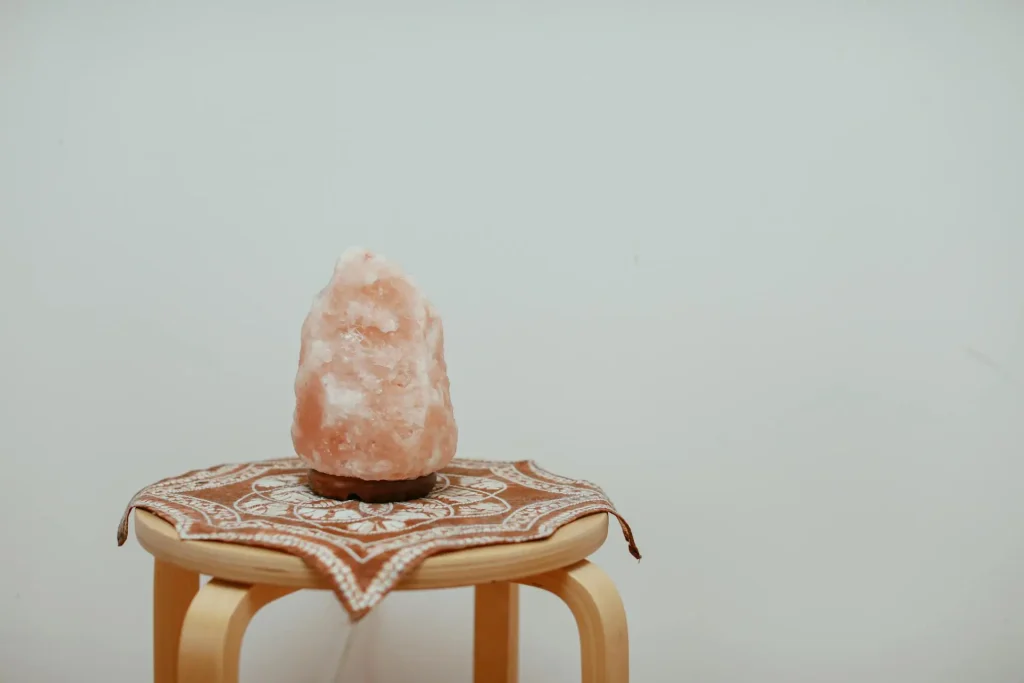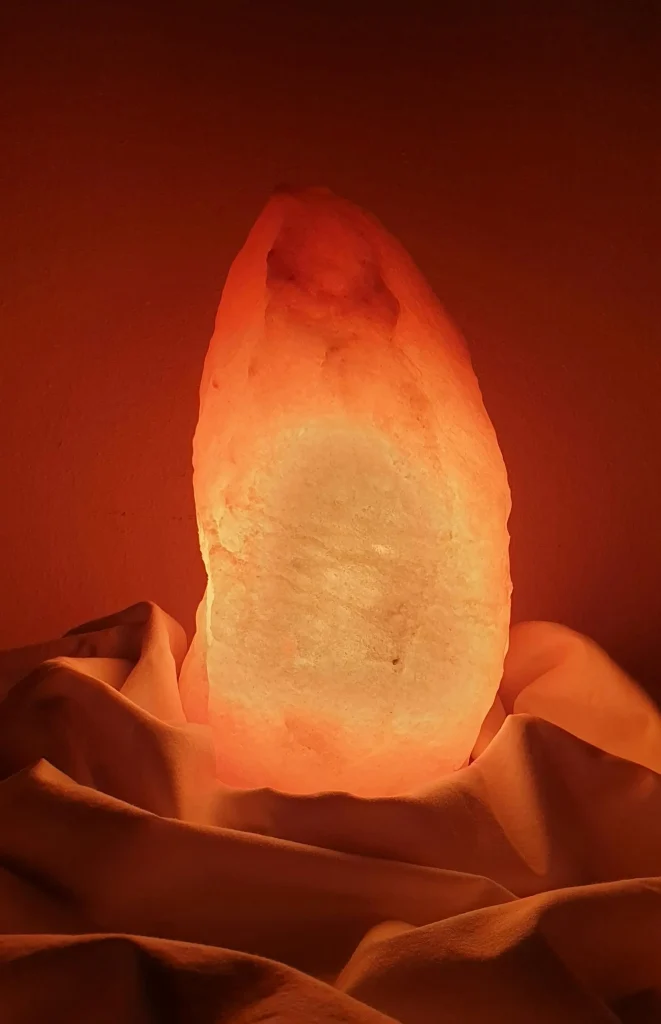Himalayan salt lamps have gained popularity in recent years, not just for their warm, soothing glow but also for their purported health benefits.
These distinctive lamps, carved from pink Himalayan salt crystals, have found their place in many homes, offices, and wellness spaces.
In this article, we’ll explore the intriguing world of Himalayan salt lamps, the potential benefits, and the best practices for using and maintaining them.

Photo by Cup of Couple
Table of Contents
What are Himalayan Salt Lamps?
They are crafted from large chunks of pink Himalayan salt, carefully hollowed out to accommodate a specific light bulb or candle.
The salt is mined from the Khewra Salt Mine in Pakistan, located in the foothills of the majestic Himalayas mountain range.
Each lamp is unique, varying in size, shape, and color, with hues ranging from soft pink to rich amber.
The Science Behind Himalayan Salt Lamps
Himalayan salt lamps are often praised for their purported benefits, and the following scientific principles may help explain their effects.
Hygroscopic Properties
Himalayan salt is naturally hygroscopic, meaning it attracts and absorbs water molecules from the surrounding air. This ability may help reduce airborne pollutants by trapping them within the water vapor that collects on the lamp’s surface, potentially improving air quality.
Negative Ion Generation
When heated, salt crystals are thought to undergo a process that may release negative ions, though the exact mechanism is debated. Some researchers suggest that the amount of ions produced by these lamps may be minimal, yet others believe that even a small number could contribute to a sense of well-being by neutralizing the positive ions generated by electronic devices.
Light Spectrum
One of the more tangible benefits of Himalayan salt lamps is the warm, orange-pink glow they emit, similar to the hues of a sunset. This gentle light may reduce blue light exposure, which has been linked to sleep disturbances, potentially helping to regulate natural sleep patterns.

Photo by monicore
Himalayan Salt Lamp Benefits
Air Purification
The previously mentioned hygroscopic nature of salt may help capture airborne particles, potentially reducing allergens and pollutants in the air. This can be particularly beneficial for individuals with allergies or sensitivities to air quality, contributing to a cleaner, more comfortable living space.
Mood Enhancement and Relaxation
The soft, warm glow of a salt lamp creates a calming atmosphere that many find soothing. This ambient lighting can reduce stress and promote relaxation, making it a popular choice for those seeking a peaceful environment. The lamp’s gentle light may also have effects similar to color therapy, which is known for its mood-enhancing properties.
Improved Sleep Quality
By potentially minimizing blue light exposure in the evening, Himalayan salt lamps might support the maintenance of natural circadian rhythms. The calming effect of the lamp’s glow may also help facilitate better sleep onset and improve overall sleep quality.
Respiratory Health Support
Salt’s natural antibacterial and anti-inflammatory properties, combined with the potential release of negative ions and salt particles into the air, might support respiratory health. For more information on this, check out the article’s section below.
Although these benefits are frequently noted and confirmed by numerous users, some claims are still not fully supported by scientific evidence.
Himalayan Salt Lamps and Respiratory Health
Sinus and Respiratory Support
The hygroscopic nature of salt lamps may help reduce humidity levels in the surrounding area, potentially creating an environment less conducive to the growth of bacteria and fungi that can cause sinus infections. Users have reported reduced inflammation in the airways, improved mucus clearance, and relief from allergy and asthma symptoms. Others reported experiencing reduced congestion and easier breathing, particularly during sleep.
Connection to Salt Therapy
Himalayan salt lamps may mimic, on a smaller scale, the effects of salt therapy or halotherapy, which involves exposure to salt-rich environments. While salt lamps don’t provide the same concentration of salt particles as dedicated salt rooms, they may offer a mild, continuous form of salt exposure in a home or office setting, potentially helping to alleviate symptoms of respiratory conditions.
Himalayan Salt Lamps in Spirituality and Energy Work
Many people integrate Himalayan salt lamps into their spiritual practices and energy work, valuing them for their perceived ability to influence energy and enhance spiritual experiences.
Chakra Alignment and Energy Cleansing
In some spiritual traditions, the warm, pinkish glow of salt lamps is believed to align and balance the lower chakras, particularly the sacral chakra; those warm hues of salt lamps are believed to stimulate creativity, enhance mood, and promote feelings of security and contentment. Additionally, salt has long been used for spiritual cleansing in various cultures, and many believe that salt lamps can help clear negative energy from a space, fostering a more positive environment.
Meditation and Feng Shui
The gentle light emitted by salt lamps is often used to enhance meditation practices, creating a serene atmosphere conducive to mindfulness and introspection. In Feng Shui, these lamps are sometimes placed strategically to promote positive energy flow, such as in the southwest corner of a room to enhance love and relationships or in the northeast to support personal growth.
Grounding and Amplification of Intentions
Some spiritual practitioners believe that salt lamps can help individuals connect to the Earth’s energy, promoting a sense of grounding and stability. They are also thought to amplify the power of intentions and affirmations set in their presence, making them a meaningful addition to various New Age practices.

Photo by Andrea Davis
How to Use a Himalayan Salt Lamp
To get the most out of your Himalayan salt lamp, consider the following tips:
Placement: Position your lamp in areas where you spend the most time, such as your bedroom, living room, or office, to maximize its benefits.
Protection: Place something underneath your Himalayan Salt Lamp to catch any potential excess moisture and protect surfaces; however don’t place anything made from metal near the lamp, to avoid the corrosion of that item.
Lighting Duration: People generally leave the lamp turned on as long as possible, however, the advice is to turn it off when it’s unattended (when you leave the house or go to sleep).
Light Intensity: Use a dimmer switch to adjust the light intensity based on your preference and the time of day, enhancing both functionality and ambiance.
Seasonal Considerations: During humid seasons, your lamp might “sweat” more due to moisture accumulation, indicating that it’s working to cleanse the air.
Caring for Your Himalayan Salt Lamp
Proper maintenance ensures the longevity and effectiveness of your salt lamp. We’ve listed some general tips below.
Cleaning: Wipe the surface gently with a slightly damp cloth when the lamp is cool and unplugged. Avoid direct contact with water to prevent damage.
Moisture Management: In high-humidity environments, turn on the lamp more frequently to reduce moisture buildup and keep it functioning optimally (although if you spot the lamp “weeping” profusely, the best would be to move it to a low humid environment).
Light Bulbs: The ones used in Himalayan salt lamps are always incandescent (heat-producing bulbs). The commonly used wattage is 15, but the final value depends on the lamp’s size. Consult with your seller on the best option and make sure to replace the bulbs as instructed.
Storage Tips: If not in use for an extended period, the best would be to store the lamp in a plastic bag in a dry place to prevent it from absorbing moisture.
Choosing the Right Himalayan Salt Lamp
When selecting a Himalayan salt lamp, consider some factors including the following ones:
Size: Choose a larger lamp for bigger rooms or multiple smaller ones to achieve the desired effect.
Color: Darker-colored lamps are often seen as more genuine and are typically preferred for their richer hue.
Shape and Aesthetics: Select a lamp that complements your aesthetic preferences and fits the intended location.
Authenticity: Ensure you purchase from a reputable seller to obtain an authentic Himalayan salt lamp.

Dangers and Drawbacks
While generally safe, you may want to check for the potential dangers and drawbacks, and consult with someone before making a final decision on enriching your environment with a Himalayan Salt Lamp.
The following article is aimed to give you some more information on that:
___________
Have you experienced the benefits of this magnificent lamp?
Feel free to share your thoughts on the topic, experiences, and tips in the comments below!
Photo by Vania K
More Articles:
- Chakras: Understanding 7 Magical Energy Centers and Their Effect on Your Well-Being
- 38 Aura Colors and Their Meaning
- Owl Symbolism: Discovering Hidden Wisdom in the Dark
